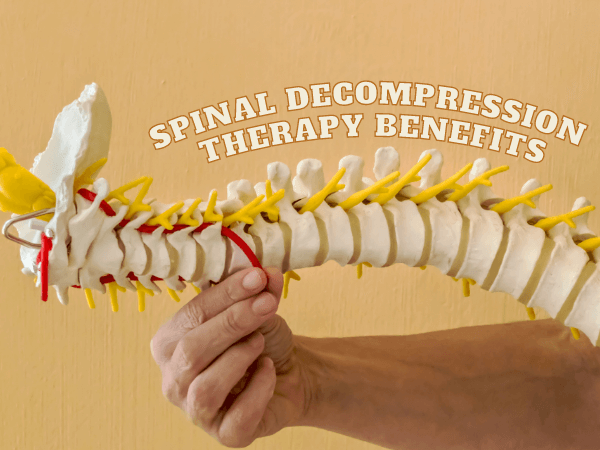Non Surgical Spinal Decompression and Traction Therapy
Spinal Decompression therapy is indicated in cases of spinal arthritis, bulging or herniated discs, and /or pinched nerves.
It is especially effective for low back and for neck issues.
In each case the patient lies on their back on the customizable spinal decompression table.

LOW BACK DECOMPRESSION
In the case of the low back, the table gently pulls the lower back away from the mid and upper parts of the body to create a stretch in the lumbar spine.
The amount of stretch is determined by the patient’s body weight.
The table gently pulls the patient into traction then brings their spine back into a neutral relaxed position, then repeats this process over the course of about 10-15 minutes.
This procedure creates a vacuum effect on the discs, creating negative pressure, which helps them to regenerate.
When repeated over time, spinal decompression therapy can help to heal bulging or herniated discs, ease the effects of spinal arthritis, or disc degeneration.
NECK DECOMPRESSION
Neck Decompression is similar to Low Back Decompression in that the patient lies on their back and their supported head gets gently pulled up and away from the torso in a similar manner as described above.
This therapy is effective for neck arthritis, degenerative disc disease, and for pinched nerves in the neck and upper back regions.
Non-Surgical Spinal Decompression and Traction Therapy: A Comprehensive Guide
Are you suffering from chronic back pain or neck pain? Have you considered non-surgical treatment options? Non-surgical spinal decompression and traction therapy might be the solution you’ve been looking for. This innovative approach offers relief for a variety of spinal conditions without the need for invasive surgery.
What is Spinal Decompression and Traction Therapy?
Spinal decompression and traction therapy is a non-invasive procedure that involves gently stretching the spine to relieve pressure on the spinal discs. This can help alleviate pain, reduce inflammation, and promote healing. The therapy is often used to treat conditions such as:
1. Herniated Discs
A herniated disc occurs when the soft, gel-like center of a spinal disc bulges or ruptures, often putting pressure on nearby nerves. Spinal decompression can help reduce this pressure, alleviate pain, and promote healing.
2. Bulging Discs
A bulging disc is similar to a herniated disc but without a complete rupture. While the disc may not be as severely damaged, it can still cause pain and discomfort. Spinal decompression can help alleviate pressure on the bulging disc and provide relief.
3. Sciatica
Sciatica is a condition characterized by pain that radiates down the leg from the lower back. It is often caused by pressure on the sciatic nerve, which is the largest nerve in the body. Spinal decompression can help relieve pressure on the sciatic nerve and reduce sciatica pain.
4. Spinal Stenosis
Spinal stenosis is a condition where the spaces within the spinal canal narrow, putting pressure on the spinal cord and nerves. Spinal decompression can help create more space within the spinal canal, reducing pressure on the nerves and alleviating pain.
5. Facet Joint Syndrome
Facet joint syndrome occurs when the small joints between the vertebrae become inflamed or damaged. This can lead to pain and stiffness in the back. Spinal decompression can help reduce pressure on the facet joints and provide relief from pain.
6. Degenerative Disc Disease
Degenerative disc disease is a condition that occurs when the spinal discs wear down over time. This can lead to pain, stiffness, and reduced mobility. Spinal decompression can help alleviate pain and improve function in patients with degenerative disc disease.
It’s important to note that while spinal decompression can be a highly effective treatment for these conditions, it may not be suitable for everyone. It’s essential to consult with a qualified healthcare professional to determine if spinal decompression is the right option for you.
How Does Spinal Decompression Work?
During a spinal decompression session, you will be placed on a specialized table that uses a controlled system to gently stretch your spine. This creates negative pressure within the spinal discs, allowing them to expand and decompress. This can help reduce pressure on the nerves and alleviate pain.
Benefits of Non-Surgical Spinal Decompression
Pain relief: Spinal decompression can significantly reduce pain associated with spinal conditions.
Non-invasive: It is a less invasive alternative to surgery, avoiding the risks and recovery time associated with traditional procedures.
Improved mobility: Many patients experience improved mobility and flexibility after undergoing spinal decompression therapy.
Faster recovery: Compared to surgery, recovery time is often shorter with spinal decompression.
Is Spinal Decompression Right for You?
To determine if spinal decompression is suitable for you, it is essential to consult with a qualified healthcare professional. They can assess your condition and recommend the most appropriate treatment plan.
Choosing a Qualified Provider
When selecting a provider for spinal decompression therapy, it is crucial to choose a qualified and experienced practitioner. Look for a provider who is knowledgeable about the procedure and has a proven track record of success. Call us today to schedule your appointment!
In summary:
Non-surgical spinal decompression and traction therapy offer a promising solution for individuals suffering from chronic back or neck pain. By gently stretching the spine and relieving pressure on the spinal discs, this innovative approach can provide significant pain relief and improve quality of life. If you are considering non-surgical options, it is worth exploring spinal decompression as a potential solution.



